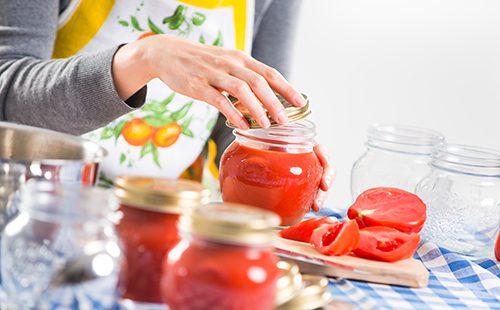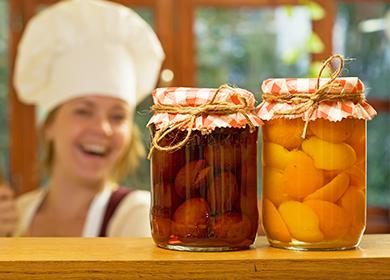Sterilization - processing containers, empty and with blanks, in order to destroy bacteria. The procedure provides long-term storage of pickles, in some cases even at room temperature.
5 rules of procedure
Do not pre-process the container: do it immediately before filling it. Here are five more rules to keep in mind.
- Safety precautions. When grabbing hot cans, gloves are required. It is important to be careful when handling steam, boiling water and high temperatures. When handling containers with disinfectants, protect your hands with rubber gloves.
- Unity. Most often, the processing time is determined by the volume of the container, therefore, while sterilizing several cans at the same time, you need to take a container of the same size.
- Jar holding. Hot containers must be held with both hands, grabbing the vessel on both sides.
- "Standby mode". The processed containers should be placed on a clean towel, turned upside down to protect them from getting into the container of germs.
- Temperature fluctuations. From a sharp temperature drop, the dishes may crack. To avoid this, heating should be carried out gradually, gloves should be used dry, hot workpieces should be laid out in hot jars, cold - in cooled ones.
Characterization of methods
Empty cans can be "cleaned" of bacteria in several ways, each of which has its own specifics. The table below gives a description of the main ones.
Table - Methods of sterilization (over 100 ° C) and pasteurization (up to 100 ° C) of empty containers
| Method | Acting factor | Benefits | disadvantages |
|---|---|---|---|
| Water bath | Hot steam | - Effective; - tested by time; - no extra fixtures needed | - Danger of burns; - steam accumulates in the room; - requires constant presence at the stove; - there is no possibility of simultaneous processing of a large number of containers |
| Boiling | Boiling water | - 100% sterility; - no extra fixtures needed | - Danger of burns; - the room is getting hot; - it is difficult to get cans from boiling water; - it is important to ensure that the containers do not touch each other |
| In the oven | High temperatures | - The ability to simultaneously process a large number of cans; - minimal risk of burns; - the room does not accumulate steam; - no need to follow the process | It's getting hot in the room |
| In the microwave | - hot steam; - microwaves | - speed; - minimal risk of burns; - maintaining a favorable microclimate in the room | - energy consumption; - small capacity |
| In a double boiler | Hot steam | - Convenience; - there is no need to monitor the process; - minimal risk of burns | - energy consumption; - small capacity |
| In the air grill | Hot air | - High heating temperature (up to 150 ° C); - thanks to the expansion ring, it is possible to process containers of large volume; - there is no need to monitor the process; - speed; - maintaining a favorable microclimate in the room | Energy consumption |
| In a slow cooker | Hot steam | - There is no need to monitor the process; - speed | - energy consumption; - small capacity |
| Hot water | - Ability to process a large number of containers at a time; - there is no need to monitor the process; - maintaining a favorable microclimate in the room | - Does not guarantee 100% sterility due to the relatively low temperature of the water; - suitable for preservation methods with further pasteurization of workpieces |
|
| In the sun | Ultraviolet | - Profitability; - there is no need to monitor the process; - does not require additional devices | - Takes a lot of time; - does not protect containers from dust; - processing is possible only on sunny days |
| Sterilants | - alcohol; - vinegar | - Low risk of burns; - low probability of damage to cans | - The time spent on the preparation of the solution; - it is necessary to rinse the container with boiling water after processing |
Many methods of preservation, in addition to processing empty containers, require additional boiling of containers already filled with blanks. During sterilization, when a temperature of 100 ° C or more is needed, this is done using an oven or air grill. During pasteurization, the temperature does not rise above the boiling point, so it’s suitable:
- water bath;
- oven;
- microwave;
- slow cooker;
- aerogrill.
Empty Tank Handling
Banks need to be carefully examined: containers with chips, cracks and dirt that cannot be removed are immediately discarded. Then the vessels are washed with warm running water with laundry soap or baking soda. Be sure to use a new sponge.
Water bath
- Fill a pot for 2/3 of the volume with water.
- Install a metal sieve or colander on top.
- Place the container with its neck down.
- After boiling, reduce heat.
- Banks for 0.5-1 liters to process 10 minutes, for 2-3 liters - 15 minutes. (Drops flowing down the walls of the tank indicate the completion of the process).
Boiling
- At the bottom of a large pan lay a towel.
- Place jars in the pan. The containers should not be in contact, so cuts of cotton cloth should be placed between them.
- Pour water into the pan so that it completely hides the container.
- Put on the stove, bring to a boil, reduce the heat so that there is no strong boiling.
- Handle a quarter of an hour.
In the oven
- Arrange dishes on a baking sheet or wire rack.
- Place in a cold oven.
- Gradually heat the electric oven to a temperature of 150 ° C, gas - up to 180 ° C.
- To process a container of 0.5 l for 10 minutes, 1 l for a quarter of an hour, 2 l for 20 minutes, 3 l for 25-30 minutes.
- Turn off the oven, let it cool down to about 80 ° C, open the door.
In the microwave
- Pour 10-20 ml of water into the container, vertically put in the microwave. If the container is three-liter, then pour 50-100 ml of water and put on its side.
- Select a mode of 700-800 watts. Set the timer for two to three minutes for dishes of 0.5-2 liters and for four to five minutes for three-liter containers.
- After the end of the process, wait one to two minutes, open the door and carefully remove the contents.
In a double boiler
- Pour water into the appropriate tank of the device.
- Place the dishes with their thumbs down in the food basket.
- Turn on the device for a quarter of an hour.
In the air grill
- Place the container in the appliance bowl with the neck up.
- Set the temperature to 120-150 ° C.
- Set the timer for five to nine minutes for containers up to 1 liter or 10-15 for containers of 2-3 liters.
In a slow cooker
- Pour two or three glasses of water into the appliance bowl.
- Set the basket for cooking food steamed and put one or two containers in it with their neck down.
- Select the “Baking” or “Steaming” mode.
- After boiling water, sterilize dishes to 0.5 l - five minutes, 0.75-1 l - seven minutes, 2-3 l - ten minutes.
In the dishwasher
- Load containers into the device.
- Set, without adding detergents, the maximum temperature mode (should be more than 60 ° C).
- Turn off the device after the process is complete, remove the container.
In the sun
- Place the cans on a clean towel with their neck down in the sunniest place of the house: on a glazed balcony or on a windowsill.
- Wait four to six hours.
- Pour boiling water.
Potassium permanganate
- Fill the dishes half the volume with a strong solution of potassium permanganate.
- Pour warm water into the tank to the top.
- Close the lid, turn upside down.
- After ten minutes, drain the solution, rinse the jar with boiling water.
Vinegar
- Dilute 70% acetic acid in cold boiled water at the rate of seven tablespoons per 0.5 l.
- Pour the solution into the jar, close, shake vigorously for 15-20 seconds, then transfer the composition to the next container.
Alcohol
- Fill a 1/3 volume jar with medical alcohol.
- Close the lid, shake well.
- Flip upside down.
- After one to two minutes, drain the alcohol.

Sterilization of containers with blanks
Jars with blanks are sterilized or pasteurized immediately before spinning. The sequence of actions is the same as when processing empty containers, only now they are covered (but not closed) by covers. Therefore, they can not be put on their side or turned upside down. The application of each method has its own specifics.
- Boiling or water bath. At the bottom of the pan, you must definitely lay a towel or put a special wooden grate. Record the processing time from the moment of boiling water.
- Oven. Heat to 100 ° C for pasteurization or to 140-180 ° C for sterilization.
- Microwave. The dishes are placed in the device without covers. Time is noted when boiling a marinade or syrup.
- Slow cooker. Pasteurization is carried out in the same way as when using a water bath. Instead of a pan - a bowl of the device. To heat the water, select the "Baking" mode.
- Air grill. Cover the lids without rubber gaskets, set the temperature to 150 ° C and above. Time is spotted from the moment bubbles appear on the surface of the workpiece.
The processing time of containers with blanks depends on its volume and the method used. Recommended parameters are shown in the table.
Table - Processing time for containers with blanks (in minutes)
| Method | 0.5 l | 1 liter | 2-3 l |
|---|---|---|---|
| Water bath | 10-15 | 20-30 | 30-40 |
| Oven | 10 | 15 | 20-25 |
| Microwave | 2-3 | 2-3 | 2-3 |
| Slow cooker | 10-15 | 20-30 | 30-40 |
When using air grill, the processing time should be reduced by 30% of the recommended in the standard formulation.
Alternative solutions
With any canning method, the workpieces are laid out in sterilized jars. However, some methods do not require additional heating filled with preservation containers. But in this case, there must be an additional "sterilizing factor", it can be:
- thermal exposure - prolonged stewing of the workpiece (vegetable salads, caviar) or serial pouring of boiling water over the products (cucumbers, peppers, green tomatoes, hard fruits);
- preservative - vinegar, citric acid, Aspirin, salt, a large amount of sugar (pickled preparations, jam, jam) are introduced into the preservation.
Experienced culinary experts consider the “hot” methods for processing containers to be the most reliable, and the use of sunlight, alcohol, potassium permanganate, or vinegar is less effective.
Other homemade recipes
Canned cabbage soup
Sea buckthorn oil
Soaked apples for the winter
Seedless Prune Jam

